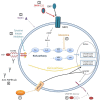New perspectives on the treatment of skeletal dysplasia
- PMID: 32166011
- PMCID: PMC7054735
- DOI: 10.1177/2042018820904016
New perspectives on the treatment of skeletal dysplasia
Abstract
The last few decades have been marked by the identification of numerous genes implicated in genetic disorders, helping in the elucidation of the underlying pathophysiology of these conditions. This has allowed new therapeutic approaches to emerge such as cellular therapy, gene therapy, or pharmacological therapy for various conditions. Skeletal dysplasias are good models to illustrate these scientific advances. Indeed, several therapeutic strategies are currently being investigated in osteogenesis imperfecta; there are ongoing clinical trials based on pharmacological approaches, targeting signaling pathways in achondroplasia and fibrodysplasia ossificans progressiva or the endoplasmic reticulum stress in metaphyseal dysplasia type Schmid or pseudoachondroplasia. Moreover, the treatment of hypophosphatasia or Morquio A disease illustrates the efficacy of enzyme drug replacement. To provide a highly specialized multidisciplinary approach, these treatments are managed by reference centers. The emergence of treatments in skeletal dysplasia provides new perspectives on the prognosis of these severe conditions and may change prenatal counseling in these diseases over the coming years.
Keywords: achondroplasia; clinical trials; endoplasmic reticulum stress; fibrodysplasia ossificans progressiva; osteogenesis imperfecta.
© The Author(s), 2020.
Conflict of interest statement
Conflict of interest statement: The authors declare no conflict of interest.
Figures



Similar articles
-
Pharmacotherapy in Rare Skeletal Diseases.Handb Exp Pharmacol. 2020;261:87-104. doi: 10.1007/164_2019_305. Handb Exp Pharmacol. 2020. PMID: 32519163
-
[Rare bone disorders and respective treatments].Internist (Berl). 2021 May;62(5):486-495. doi: 10.1007/s00108-021-00995-1. Epub 2021 Mar 29. Internist (Berl). 2021. PMID: 33779789 Review. German.
-
Osteochondral diseases and fibrodysplasia ossificans progressiva.Adv Exp Med Biol. 2010;686:335-48. doi: 10.1007/978-90-481-9485-8_19. Adv Exp Med Biol. 2010. PMID: 20824454 Free PMC article. Review.
-
The evolving therapeutic landscape of genetic skeletal disorders.Orphanet J Rare Dis. 2019 Dec 30;14(1):300. doi: 10.1186/s13023-019-1222-2. Orphanet J Rare Dis. 2019. PMID: 31888683 Free PMC article. Review.
-
Current and Emerging Therapeutic Options for the Management of Rare Skeletal Diseases.Paediatr Drugs. 2019 Apr;21(2):95-106. doi: 10.1007/s40272-019-00330-0. Paediatr Drugs. 2019. PMID: 30941653 Review.
Cited by
-
Clinical management and emerging therapies of FGFR3-related skeletal dysplasia in childhood.Ann Pediatr Endocrinol Metab. 2022 Jun;27(2):90-97. doi: 10.6065/apem.2244114.057. Epub 2022 Jun 30. Ann Pediatr Endocrinol Metab. 2022. PMID: 35793999 Free PMC article.
-
Optimising the diagnosis and referral of achondroplasia in Europe: European Achondroplasia Forum best practice recommendations.Orphanet J Rare Dis. 2022 Jul 27;17(1):293. doi: 10.1186/s13023-022-02442-2. Orphanet J Rare Dis. 2022. PMID: 35897040 Free PMC article.
-
What the pediatric endocrinologist needs to know about skeletal dysplasia, a primer.Front Pediatr. 2023 Aug 22;11:1229666. doi: 10.3389/fped.2023.1229666. eCollection 2023. Front Pediatr. 2023. PMID: 37675393 Free PMC article. Review.
-
ROR2-Related Skeletal Dysplasia Reveals Disrupted Chondrocyte Polarity through Modulation of BMP/TGF-β Signaling.Aging Dis. 2024 Feb 1;15(1):282-294. doi: 10.14336/AD.2023.0531. Aging Dis. 2024. PMID: 37307827 Free PMC article.
-
Changes in skeletal dysplasia nosology.Rom J Morphol Embryol. 2021 Jul-Sep;62(3):689-696. doi: 10.47162/RJME.62.3.05. Rom J Morphol Embryol. 2021. PMID: 35263396 Free PMC article.
References
-
- Mortier GR, Cohn DH, Cormier-Daire V, et al. Nosology and classification of genetic skeletal disorders: 2019 revision. Am J Med Genet A 2019; 179: 2393–2419. - PubMed
-
- Kronenberg HM. Developmental regulation of the growth plate. Nature 2003; 423: 332–336. - PubMed
-
- Hayrapetyan A, Jansen JA, van den Beucken JJ. Signaling pathways involved in osteogenesis and their application for bone regenerative medicine. Tissue Eng Part B Rev 2015; 21: 75–87. - PubMed
Publication types
LinkOut - more resources
Full Text Sources

